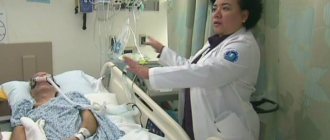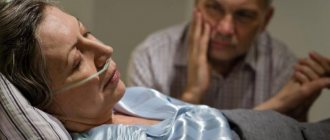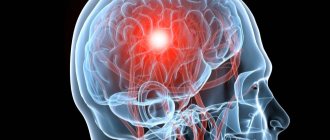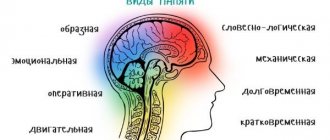Why does the patient fall into a coma?
Coma after a stroke is a consequence of a decrease or cessation of blood flow in some areas of the brain, so the patient plunges into an unconscious state with a partial loss of reflexive reactions.
There is an acute violation of cerebral circulation with rupture of blood vessels and hemorrhage in the brain (hemorrhagic stroke) and a violation of cerebral circulation with damage to brain tissue, its dysfunction due to difficulty or cessation of blood flow to one or another department (ischemic form of pathology).
The following factors are identified that lead to coma:
- cerebral bleeding with high blood pressure;
- insufficient blood supply to one or more internal organs;
- swelling of the brain due to hormonal imbalance and low oxygen content in the body or individual organs and tissues;
- degeneration of the walls of large vessels;
- intoxication of the body;
- systemic pathology, characterized by the destruction of connective tissue and a progressive course, when the development of the disease is based on an immunopathological process that disrupts collagen metabolism (collagenosis);
- avitaminosis;
- various blood diseases.
With a hemorrhagic stroke, a coma can lead to death, because death of large areas of the brain is observed, and in ischemic cases, patients in most cases come out of the coma on their own.
Degrees of coma
There are such degrees of coma in hemorrhagic stroke of the brain:
- The first is characterized by the predominance of inhibition processes over excitation processes. The patient does not respond to pain and light stimuli. The patient can swallow and roll over.
- The second is characterized by the absence of reactions and constriction of the pupils. The patient's breathing is uneven, spontaneous muscle contractions are possible. There is a risk of death in a coma after a stroke.
- The third is characterized by the absence of reflexes, convulsions are possible. Body temperature drops significantly, involuntary acts of defecation are recorded. These symptoms occur due to damage to brain structures.
- The fourth is characterized by a lack of normal tone of skeletal muscles and internal organs; the condition develops due to a lack of general nutrition. The pupils are dilated, breathing is characterized by long delays. When a patient is in a deep coma, it is no longer possible to regain consciousness.
Important information: Indications (contraindications) for craniotomy during stroke and possible consequences
Stages of coma
The prognosis of treatment depends on the degree of coma detected during a stroke. A person with precoma or stage 1 comatose disorders has a more favorable prognosis than when a deep cerebral coma is detected.
It is important to know!
With timely provision of medical care, the comatose process can be stopped and the severity of possible consequences reduced.
Prekoma
The main characteristic of the resulting state: deep stunning. In this case the person:
- excited or depressed;
- unable to answer questions;
- cannot understand speech addressed to him.
Often the state of stunning provokes the appearance of hallucinations and psychopathic delusions.
Reflexes and motor functions are preserved, but the victim feels severe weakness. If help is not provided to the patient, a coma occurs.
1st degree
The patient falls into a state of stupor and upon examination it is noted:
- slower response to external stimuli;
- moderate muscle hypertonicity;
- “floating” look;
- decreased pain sensitivity.
A patient in a 1st degree coma retains water or liquid food, can move independently, but is unable to communicate and does not understand speech.
The prognosis for the first degree depends on the duration of the comatose process. If the patient was unconscious for a short time and the therapy was carried out in a timely manner, then there is a chance to avoid serious consequences.
2nd degree
Stupor or coma 2 degrees causes more severe consequences:
- lack of consciousness;
- uncontrolled chaotic movements;
- constriction of the pupils and poor reaction to light;
- breathing problems (becomes deep and noisy);
- the appearance of convulsive twitching (muscles tense and relax uncontrollably);
- weakening of the sphincters, accompanied by involuntary defecation and urination.
The prognosis of the second degree depends on the nature of the brain lesion. Ischemic stroke has fewer consequences and with timely assistance, recovery is possible, but the chances of full recovery are reduced.
Hemorrhagic stroke is more dangerous and symptoms progress quickly. Some people who fall into a coma after a hemorrhagic stroke die in the first hours, and those who survive almost always remain disabled.
3rd degree
The third stage or deep coma is characterized by the development of severe disorders:
- no consciousness;
- all reflexes are absent;
- pupils are constricted;
- atony (possible convulsions with loss of breathing for a short time);
- decrease in blood pressure;
- frequent shallow breathing;
- control over natural healing has been lost (patients urinate and walk around largely “under themselves”).
Coma of the 3rd degree often occurs with hemorrhagic stroke with extensive hemorrhage.
In the third degree, the prognosis is unfavorable and the consequences of brain disorders are almost irreversible.
4th degree
There is no prognosis for survival - stage 4 coma causes the death of the cerebral cortex. The patient does not have:
- spontaneous breathing;
- pupil reaction;
- protective reflexes;
- muscle tone.
There is no pulse in large vessels, pressure is not determined. The patient's life can only be saved by connecting to a life support machine.
Clinical picture
There are the following signs of coma during a stroke:
- Prolonged stay in an unconscious state.
- Insufficient brain activity.
- Uneven breathing.
- The pulse is difficult to palpate.
- Weak heart rhythm.
- Hypotension.
- Lack of response to various kinds of stimuli.
- Involuntary urination and bowel movements.
The clinical picture is individual in each individual case. It all depends on the degree of brain damage and the general condition of the internal organs.
How is the body maintained during a coma?
With a stroke, there are comas, from which the patient emerges within the first few days or hours; in this case, special care is not needed. It is enough to prescribe restorative and restorative therapy. If the victim is unconscious for a long time, the victim will need medical attention to maintain life.
Drug therapy for deep sleep
The purpose of prescribing medications is to increase the patient’s brain activity and restore lost functions.
The prescribed treatment is aimed at preventing and combating possible or existing complications. Therapy is prescribed on a case-by-case basis, depending on the patient’s condition. If the temperature rises, sepsis or bedsores occur, an infectious disease is diagnosed, and a course of antibiotics is given. To improve brain activity, neoprotectors are prescribed.
What care does a patient in a coma require?
The desire of relatives to care for a sick person is commendable. But in the case of a person who has been unconscious for a long time, qualified medical assistance will be required.
The victim must be connected to an artificial respiration apparatus and other life support systems. It is recommended that the patient remain in the medical center at all times, so that the staff will be able to recognize the early signs of recovery from a coma and provide the necessary assistance.
Particular attention should be paid to preventing the development of pressure ulcers. To maintain proper body hygiene, it is recommended to use special diapers and an anti-bedsore mattress
Introduction to induced coma
Stroke and coma are often accompanying conditions, but sometimes there is a necessary relationship in order to save the patient’s life. Drug induction into a coma is practiced to exclude changes in areas of the brain.
It is important to consider a number of such features:
- An induced coma is appropriate when it comes to pressure on brain tissue and swelling due to hemorrhage. This way you can replace anesthesia during a critical period.
- Reducing pain sensitivity (analgesia) promotes constriction of blood vessels and reduces the tension of cerebral blood flow. The death of brain cells can be avoided.
- Immersion in deep sleep occurs due to the intravenous administration of drugs that act as a depressant on the central nervous system.
- Sedation requires constant monitoring of the patient's clinical parameters. Any reactions (for example, to a light stimulus) indicate the return of consciousness. Therefore, it is important for doctors to provide timely assistance when the patient comes out of a coma.
- Introduction to an artificial coma is accompanied by adverse reactions, which are expressed by impaired respiratory function (tracheobronchitis, pneumonia), renal failure, and pathologies of the nervous system.
Treatment and care
Coma due to hemorrhagic stroke does not have clear time boundaries, so it is impossible to make predictions. But medical care is important while the patient is unconscious.
Important information: What you can (cannot) eat in the first days after a cerebral stroke (ischemic) and nutrition at home for bedridden patients
Nutrition
Food should be liquid, because... it enters the stomach through an inserted tube. Children's milk formulas and fruit purees prepared at home are common.
Hygiene
It is important to monitor the cleanliness of the patient’s body: daily cleanse the skin of sweat with a soap solution, brush your teeth with gauze soaked in soda. It is necessary to comb your hair and wash your hair at least once a week.
Therapy
A person in a coma after a stroke needs artificial ventilation.
It is necessary to remove the hematoma inside the brain, because... Such surgery increases the chances of recovery.
The following medications are prescribed:
- chemicals and medications that inhibit the activity of the blood coagulation system and prevent the formation of blood clots (anticoagulants);
- neurometabolic stimulants are drugs intended to provide a specific effect on higher mental functions (nootropics).
Caring for patients in coma
Unconscious people need to be fed and hygienic. If a person breathes independently, then hygiene procedures are limited to washing and preventing bedsores.
In the absence of spontaneous breathing, artificial ventilation is indicated. If mechanical ventilation is performed for a stroke, it is necessary to sanitize the breathing tube to remove accumulated mucus. This will help reduce the risk of developing congestive pneumonia.
Treatment and methods of preventing bedsores
Nutrition
If a person falls into a coma, he cannot eat on his own. How people in a coma are fed depends on the duration of the comatose process:
- the first few days a person is given intravenous infusions of nutrient solutions;
- if there is no improvement and the patient cannot swallow food on his own, then the patient is fed through a gastric tube.
If feeding is carried out using a tube, then baby food, liquid fruit and vegetable purees, and broths are used.
Hygiene
To prevent the formation of bedsores and other complications, every day the patient must:
- wash the body with water and hypoallergenic soap;
- cleanse the oral cavity of mucus;
- comb your hair.
Hair washing is carried out at least once a week.
To prevent bedsores, it is necessary to frequently change the patient's position in bed and place bolsters or pads under pressure areas.
How to bring a person out of a coma
Coming out of a coma after a stroke consists of the following stages:
- The swallowing function is weakly expressed, the skin and muscles begin to react to external stimuli. The patient can move his head, arms and legs. In this case, the doctor records the positive dynamics of clinical symptoms.
- The patient experiences hallucinations, consciousness gradually returns, cognitive processes are restored, speech and vision partially function.
- The return of motor activity is observed: the patient can sit, rises a little, but does not walk without assistance.
When a person comes out of a coma, it is necessary to conduct a tomographic study to identify the affected areas of the brain in order to determine a treatment program.
Someone who has come out of a coma needs psychological support, because... he cannot return to his usual activities and lifestyle, which creates additional stress.
It is necessary to bring a person out of a coma sequentially, because a stroke could lead to the destruction of brain cells, which is accompanied by the loss of functions important for life. To avoid the spread of destruction to other parts of the brain, competent rehabilitation is necessary, including physical exercises with a gradually increasing level of difficulty.
Important information: List of medications for the treatment of cerebral stroke
It is recommended to come out of a coma surrounded by loved ones who can morally support a sick family member.
Lots of problems
So, for the first stage of rehabilitation, I chose home conditions. After all, at home, as you know, even the walls help.
Let me note right away that it is very important for relatives of stroke patients to learn to make decisions for their patients. And this is not so easy anymore. Especially when you have to take care of your parents. The attitude of seniority in such situations must be broken without timidity or embarrassment. Now it’s not my mother, but I, who is responsible for everything that happens to her and to me.
With a list of medications needed for my mother, received from her attending physician in the hospital, a speech therapy manual for restoring speech function and a list of physical exercises, and with the support of a visiting doctor and paramedic from the district clinic (this service appeared on October 1), I was sure that my mother and I 100 percent armed against the consequences of a stroke.
However, the visiting doctor said that he would visit us once every three months, and the paramedic - once every one and a half months. The neurologist will be able to come only in two weeks. Neither a speech therapist nor a physical therapy specialist will make house visits.
Article on the topic
Live in a new way. How does a psychologist help patients who have had a stroke?
Consequences and prognosis
If a coma is observed with an extensive lesion with cerebral hemorrhage, then it is difficult to predict the timing of recovery from the unconscious state. In this case, it is important to take into account the presence of surgical intervention and the individual characteristics of the body.
How many days does it last
With an ischemic stroke, a person can remain in a coma for no more than a day, which is due to the fact that the area of brain damage is not as large as in the hemorrhagic form of the attack.
The comatose state lasts for a long time in the presence of extensive foci of cell damage. The patient remains unconscious for 2 weeks. But it is not uncommon for a coma to last 50 days or even several years.
If brain cells are not saturated with oxygen for more than 30 days, then it is almost impossible to bring a person back to life. We are talking about maintaining vitality through special medical equipment, because... euthanasia is prohibited in Russia.
Chances of Survival
If there is a coma after a stroke, the chances of survival are minimal, but the patient's age plays a big role. The probability of survival is quite high in patients with ischemic stroke. A more accurate prognosis can be obtained using laboratory blood tests and tomography.
Death occurs within 3 days after entering a comatose state. They do not live after a coma if the following factors occur:
- repeated attack that led to coma;
- lack of response to sound and light stimuli, pain;
- age category over 65 years;
- decrease in serum creatinine to a critical level - 1.5 mg/dl;
- extensive lesions of brain tissue;
- death of brain cells.
It is important to take into account concomitant chronic disorders and the desire to live of the patient himself.
Degrees of condition
How long a coma will last after a stroke depends on the initial condition of the patient, but this time is usually 2-10 days. Less often, the patient is in a state of sleep for less than 24 hours. A person is rarely unconscious for several years or months after a blow.
It is impossible to determine exactly at the moment sleep begins how many people will remain in it.
But there is one important pattern: the longer a person is in this state, the lower the risks of surviving and returning to normal life. The duration of sleep also affects the ease of recovery after being in a coma. In 70-90% of clinical cases, a person remains with 1-3 degrees of disability, and important body functions are lost. There are 4 degrees of coma after a stroke:
- Pre-coma . The person is in normal consciousness, his muscles are working, but lethargy and loss of tone are noticeable. Partial numbness of the skin occurs. At this stage, the transition to unconsciousness can be prevented
- Second degree . At this moment, the person falls into a deep unconscious sleep and stops responding to any stimuli. Breathing gradually changes: it becomes noisier and more intermittent, and the muscles begin to contract involuntarily.
- Third degree . It is formed mainly during a major stroke. The person completely loses consciousness, physiological reactions, including muscle cramps, go away. The temperature is decreasing.
- Fourth degree . In this case, the chances of surviving a coma caused by a stroke are almost zero. Even spontaneous breathing, which remains a reflex, is absent. The person is connected to special devices.
In unconscious sleep, a person needs special care from medical personnel: he is fed, served, and kept alive in accessible ways.










